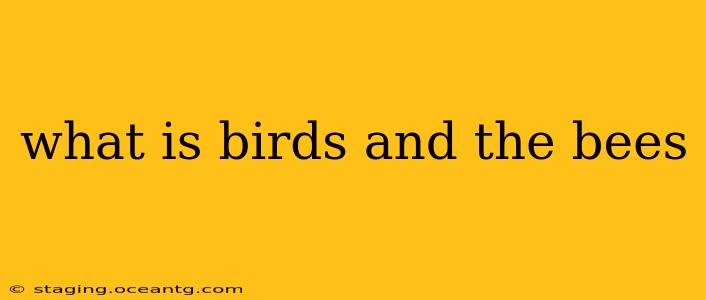What is "Birds and the Bees"? Understanding the Facts of Life
The phrase "birds and the bees" is a euphemism used to explain the basics of human reproduction and sexual intercourse to children. It's a delicate topic, and the phrase itself hints at the indirect and often metaphorical way adults traditionally approached the subject. Instead of directly discussing sex, they used analogies about the natural world, hence the birds and the bees.
The actual meaning, however, goes beyond a simple analogy. It encompasses the entire process of how humans reproduce, from the biological mechanisms to the social and emotional aspects of sex and relationships. Let's break down the key elements often included in "the birds and the bees" conversation:
What are the biological aspects of reproduction covered by "birds and the bees"?
This part focuses on the biological processes involved in creating a new human life. It typically includes:
- Male and Female Reproductive Systems: A simplified explanation of the male and female reproductive organs and their functions. This might include a discussion of sperm, eggs, and fertilization.
- Fertilization and Pregnancy: How a sperm fertilizes an egg, leading to the development of an embryo and eventually a fetus.
- Gestation and Birth: The nine-month gestation period, fetal development, and the process of childbirth.
What about the social and emotional aspects?
Beyond the purely biological, "birds and the bees" conversations often touch upon:
- Relationships and intimacy: The importance of healthy relationships, consent, and responsible sexual behavior.
- Emotional maturity and readiness: Understanding that sex is a significant act with emotional consequences and requires maturity and responsibility.
- Safe sex practices: The importance of protecting oneself from sexually transmitted infections (STIs) and unwanted pregnancies through safe sex practices like abstinence, correct condom use, and regular STI testing.
How should I talk to my child about "birds and the bees"?
The best approach is age-appropriate and honest communication. Start with simple explanations based on their current understanding of the world. As they get older, gradually provide more detailed information. Remember to:
- Be open and approachable: Create a safe space for them to ask questions without feeling embarrassed or judged.
- Use accurate terminology: Avoid euphemisms or overly simplified explanations that could be confusing or misleading later on.
- Listen and answer their questions honestly: Address their concerns and answer their questions to the best of your ability. If you don't know the answer, it's okay to say so and find a reliable source together.
What are some resources to help me explain "birds and the bees"?
There are many age-appropriate books and websites designed to help parents explain sex education to their children. Many libraries and schools also offer resources on sex education. It's important to select resources that are accurate, inclusive, and appropriate for your child's age and developmental level.
At what age should I have "the birds and the bees" talk?
There's no single "right" age. It depends on the child's maturity, curiosity, and developmental stage. Start early with basic concepts about where babies come from and expand as they ask more questions. Be guided by their questions and understanding. It's an ongoing conversation, not a single event.
The "birds and the bees" conversation is an essential part of a child's development, providing them with the knowledge and understanding they need to navigate their sexuality responsibly and healthily. It’s a journey, not a destination, and open communication is key.
